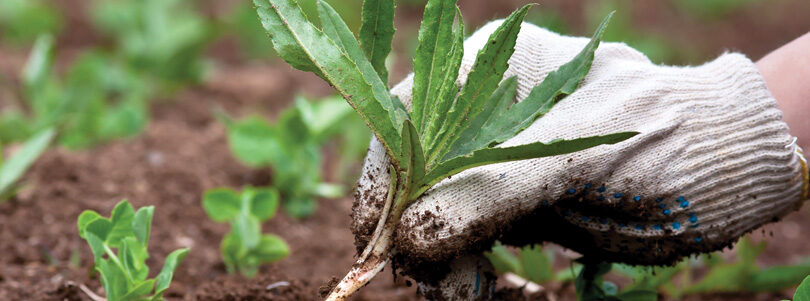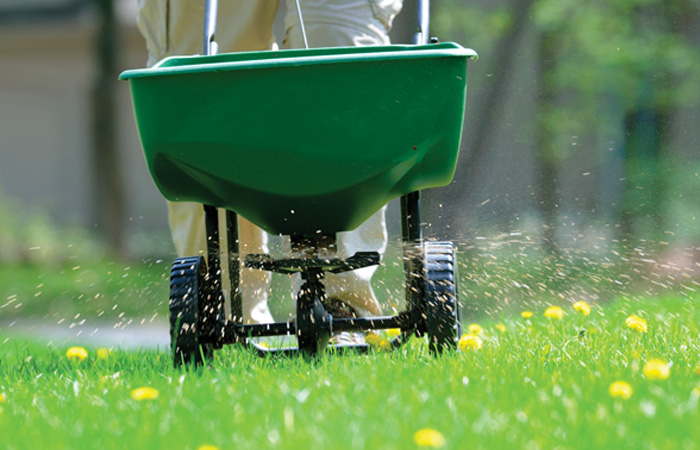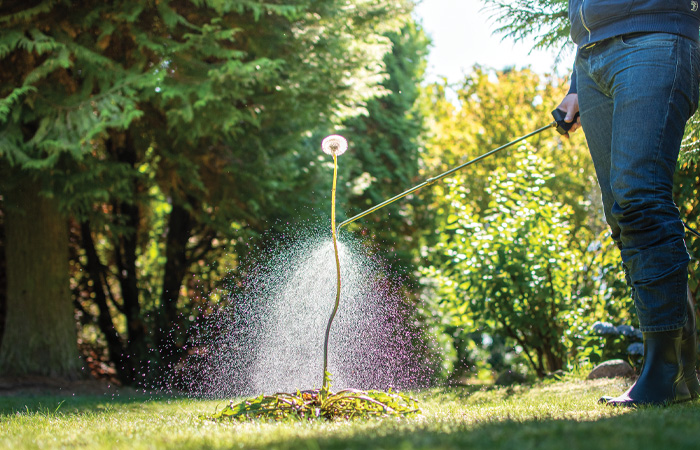Ask the Superintendent – The War on Weeds

Greetings avid golfers, and welcome to February! The North Texas weather has lived up to its reputation for unpredictability so far this winter. We held great color on the warm-season grasses late into the year; that is, until the polar vortex rolled through and gave us three days of below-freezing weather and a solid 11-degree low temperature in the midst of it.
If your home course has ultra-dwarf Bermuda greens, then you saw the covers come out early and stay out through the freeze. Yes, a lot of landscape plants were damaged (again). You can see the Ligustrum, Indian Hawthorn and other plants dropping leaves and will likely require heavy pruning or replacement. We will have to wait a while to see if there will be significant turf damage, and we know that there is some more cold weather ahead. It is not unheard of for us to have frosts well into April.
That said, after the deep freeze we saw temperatures reach 80 degrees and we were still on the dry side, which keeps us all checking moisture levels like it’s still summer. I point all this out to remind everyone that we often can get most things right when it comes to turf and ornamentals, and still Mother Nature throws us a curveball and we adjust, adapt and press on. All these weather swings have actually given us some pretty good golf days (wind aside). It would be an easy year to forget your spring/summer weed control. But not on my watch!
So, to keep my promise to always feature some form of weed-control topic for our Ask the Superintendent question in February, this month’s question is, “How do I control the weeds in my lawn?” Step onto the course, avid golfers, and walk with me once again through the critical steps as we answer this most ardent and timely of questions … to set you on the path to a better home lawn, no matter what Mother Nature throws at us.

First Things First
Faithful readers of our column will remember as we covered the value of a home landscape last year, that one of the main components was a heathy, weed-free lawn. Focus for the time being on the weed-free. So, as we start the journey to a great lawn, it is important to know what type of turf grass you have in your lawn before you start developing a weed-control program.
Common turf grass types in North Texas include Bermuda grass, Zoysia grass, Saint Augustine, centipede grass and Fescue, to name a few. Each type of grass has different light, soil and fertility requirements, as well as growth and environmental factors, so knowing that you have picked the best-suited grass for your lawn’s environment is important. Healthy turf is the first step in controlling invasive weeds. A healthy base turf can suppress many weeds before they can establish themselves in the sward (turf stand). Assuming that you have the right grass in place, we will move on to defining what a weed is and how to control weeds that will eventually challenge your goal of a beautiful lawn.
What is a Weed?
What exactly is a weed? For our purposes today, we will define a weed as a plant growing where it is not wanted and in competition with desired/cultivated plants (lawn). Essentially, any plant that is growing where it is not wanted is a weed. So, Bermuda grass growing in a Saint Augustine lawn is considered a weed.
In terms of lawn or turf weeds, they come in two basic groups: winter or cool-season weeds (henbit, chickweed and poa annua, or common meadow grass to our friends from the UK) and summer or warm-season weeds (goose grass, crabgrass and nutsedge). These weeds begin to germinate at different times of the year: the cool-season grasses in late summer/early September through October, and the warm-season grasses from mid-February through May.
There are two basic approaches to weed control: physical and chemical. Physical weed control is pretty simple. You literally remove the weed physically. This is often impractical, depending on the number and establishment of the weed population, but it does work. Chemical weed control is achieved through the use of herbicides (an agent, usually chemical, used to kill plants). Herbicides also come in two primary groups, pre-emergent and post-emergent herbicides. Pre-emergent herbicides are applied BEFORE (thus the urgency in the spring edition weed control article) the weed plant germinates, killing the plant just after seed germination before a root can establish in the soil. Post-emergent herbicide is applied to existing weeds and often require direct contact to be effective. There are a few pre-emergent herbicides that have some post-emergent characteristics, but by and large you will make the choice of herbicide based on the time germination of the weed. Post-emergent herbicides can also be selective (kill certain plants but will not harm others) and non-selective (will kill or damage most plants that contact the product).
Timing is Everything!
It is critical that a pre-emergent herbicide be applied properly and at the right time of year to be truly effective. So now is the time to apply pre-emergent to control summer or warm-season weeds, starting in February and extending into March. We will not go into all the factors that affect weed seed germination; just know that pre-emergents are most effective if they are applied before the weed seed germinates. In fact, pre-emergent herbicides prevent the germination of weed seeds by inhibiting a key enzyme and should be applied spring and fall to provide year-round weed protection. It is important that the herbicide make good soil contact to be effective, so watering in the product is recommended. Most homeowners will likely choose a granular pre-emergent, which can be purchased from your local nursery or garden center.
Two great products for pre-emergent weed control are Prodiamine (Barricade equivalent), which is the longest lasting and most economical due to lowest application rates; and Isoxaben (Gallery equivalent), which prevents a very large list of broadleaf weeds. There are others to choose from, and there is always ongoing turf research that brings us new and more effective products that are effective and environmentally safe.
Once you have purchased your product, simply follow the instructions on the product label that is attached to the bag/container. If you have questions or want the latest tips on turf grass in Texas, the Texas A&M Agrilife Extension program can help either online or by phone. To improve your results, you may consider making a spilt application of the herbicide. This involves making two applications at 50 percent of the recommended product rate. This allows one application early in the season and a second several weeks later to offer a larger window of control without overapplying the active ingredient (AI) of the herbicide.
A few pro tips include: the smaller the size of the fertilizer granule, generally the better the distribution and coverage. Make sure you apply the product in two opposite directions to avoid skips or tiger striping. Also be sure to check the percent AI (Active Ingredient) in the bag, as often the cheaper products have less actual herbicide in them. After all, we are actually buying weed control, not filler products.
If you are making a granular pre-emergent herbicide application, here is a quick reminder of how to calibrate your rotary spreader.

How to Calibrate a Rotary Spreader
Determine the amount of fertilizer/product needed for 100 sq. ft. For example, the fertilizer bag weighs 50 lbs. and covers 10,000 square feet per the label recommendation.
Place this amount in the spreader.
Mark off the area. For a rotary spreader, use a 10-foot by 10-foot area (100 sq. ft.).
Apply using the suggested label setting to the test site.
Adjust the setting up or down based on the actual amount of fertilizer applied; if you covered the area completely with nothing left in the spreader, you are perfect! If you have product left in the hopper, increase the spreader setting. If you run out of product before the area is covered, then decrease the setting. Repeat this process until you find the correct setting. Take notes for future reference.
Complete the application for the rest of the lawn.
One Last Thing
Weed control is an ongoing process of controls and actions that strengthen the base turf grass and eliminate invasive plants. It is February, so if you see mature weeds in your lawn, they are winter weeds (see paragraph three) and will not be killed by a pre-emergent herbicide applied now. Just remember that the spring pre-emergent application prevents summer weeds, and a fall pre-emergent application prevents winter weeds. I promise we will once again cover fall weed control in September/October. However, there are no 100-percent effective pre-emergent weed control products available, so using some physical removal and post-emergent herbicide applications are also required to be most effective.
Be diligent, safe (follow the label instructions) and, as always, thank your golf course superintendent.



